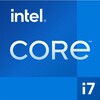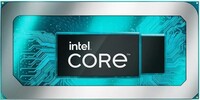Intel Core i5-14500HX vs Intel Core 9 270H vs Intel Core 5 210H
Intel Core i5-14500HX
► remove from comparison
The Intel Core i5-14500HX is a high-end CPU from the Raptor-Lake-HX Refresh series (RPL-H). The CPU offers all 6 performance cores (P-cores, Golden Cove or Raptor Cove architecture) and 8 efficiency cores (E-cores, Gracemont architecture). The P-cores support hyperthreading (therefore 20 threads together) and clock from 2.4 to 4.9 GHz (single-core turbo). The E-cores clock from 1.9 - 3.7 GHz and should offer comparable performance to old Skylake cores (e.g. i7-6920HQ).
Performance
Thanks to the higher clock rates of the Rocket Lake series, the i5-14500HX can reach the level of the old Core i9-12900H and is therefore a very fast mobile CPU that is ideal for all areas of application.
Graphics unit
Like its predecessor, Intel integrates an Intel Xe-based graphics unit. In the 14500HX, all 96 EUs are activated and clock at up to 1.55 GHz.
Features
Like Alder-Lake-H, Raptor-Lake-H has partially integrated WiFi 6E and Thunderbolt 4 (4x). The integrated memory controller now supports faster DDR5-5200 memory. The integrated Gaussian and Neural Accelerator (GNA) is still installed in version 3.0. The Quick Sync 8 media engine is the same as in Rocket Lake and supports MPEG-2, AVC, VC-1 decode, JPEG, VP8 decode, VP9, HEVC and AV1 decode. The chip supports PCIe 5.0 x8 for a dGPU and two PCIe 4.0 x4 for SSDs. The PCH also offers PCIe Gen3 x12.
Power consumption
The Intel Core i5-14500HX is specified with 55 watts TDP (PL2 157 watts). The processor continues to be manufactured using the improved Intel 7 process (10 nm SuperFin).
Intel Core 9 270H
► remove from comparison
The Intel Core 9 270H is a high-end mobile CPU for laptops based on the Raptor Lake-H series (Alder Lake architecture). It was announced in late 2024 and offers 6 performance cores (P-cores, Golden Cove architecture) and 8 efficient cores (E-cores, Gracemont architecture). The P-cores support Hyper-Threading for 20 threads when combined with the E-cores. The clock rates range from 2.7 to 5.8 GHz (single core turbo) on the performance cluster and 2 to 4.1 GHz on the efficiency cluster. The performance of the E-cores should be similar to old Skylake cores (comparable with the Core i7-6920HQ). All cores can use up to 24 MB L3 cache.
Compared to the pre-refresh top model, the Core i9-13900H, the Core 9 270H offers a 400 MHz higher Turbo clock speed and supports slightly faster DDR5-5600 RAM.
Performance
The average Core 9 270H should be slightly faster than a Core i9-13900H thanks to the higher Turbo clock speed. Especially single core workloads can profit from the higher frequency. Supplied with ample cooling and TDP, the Core 9 270H should be sufficient even for very demanding tasks.
Features
The integrated memory controller supports various memory types up to DDR5-5600 (up from 5200 MHz for the 13th gen). The Thread Director (in hardware) can support the operating system to decide which thread to use on the performance or efficient cores for the best performance. For AI tasks, the CPU also integrates GNA 3.0 and DL Boost (via AVX2). Quick Sync in version 8 is the same as in the Rocket Lake CPUs and supports MPEG-2, AVC, VC-1 decode, JPEG, VP8 decode, VP9, HEVC, and AV1 decode in hardware. The CPU now supports PCIe 5.0 x8 for a GPU and two PCIe 4.0 x4 for SSDs.
The integrated graphics adapter is based on the Xe architecture and offers 96 EUs (Execution Units) that are clocked at up to 1.55 GHz.
The CPU is rated at 45 W base power (115 W PL2) but most laptops will use a PL1 of around 60 Watt. The SoC is manufactured on an improved 10nm process at Intel, which is known as Intel 7.
Intel Core 5 210H
► remove from comparison
The Intel Core 5 210H is a mid-range mobile CPU for laptops of the Raptor Lake-H series (Alder Lake architecture). It was announced in late 2024 and offers 4 of the 6 performance cores possible (P-cores, Golden Cove architecture) and 4 of the 8 efficient cores (E-cores, Gracemont architecture). The P-cores support Hyper-Threading making for 12 processing threads when combined with the E-cores. The clock rates range from 2.2 to 4.8 GHz (single core boost) on the performance cluster and 1.6 to 3.6 GHz on the efficient cluster. The performance of the E-cores should be similar to old Skylake cores (comparable to the Core i7-6700HQ). All cores have access to the 12 MB L3 cache.
Compared to the old Core i5-13420H, the Core 5 210H offers slightly higher clock speeds (e.g. boost core speeds + 200 MHz).
Performance
Thanks to the higher clock speeds, the Core 5 210H can surpass the old Core i5-13420H, especially in single threaded workloads.
Features
The integrated memory controller supports various memory types up to DDR5-5200 (up from DDR5-4800 of the i5-12500H). The Thread Director (in hardware) can help the operating system to decide which thread to use on the performance or efficient cores for the best performance. For AI tasks, the CPU also integrates GNA 3.0 and DL Boost (via AVX2). Quick Sync in version 8 is the same as in the Rocket Lake CPUs and supports MPEG-2, AVC, VC-1 decode, JPEG, VP8 decode, VP9, HEVC, and AV1 decode in hardware. The CPU now supports PCIe 5.0 x8 for a GPU and two PCIe 4.0 x4 for SSDs.
The integrated graphics adapter is based on the Xe architecture and offers 48 of the 96 EUs (Execution Units) possible.
The CPU is rated at 45 W base power (115 W PL2) but most laptops will use a PL1 of around 60 Watt. The SoC is manufactured on an improved 10nm process at Intel, which is known as Intel 7.
| Model | Intel Core i5-14500HX | Intel Core 9 270H | Intel Core 5 210H | ||||||||||||||||||||||||||||||||||||||||||||||||||||||||||||
| Codename | Raptor Lake-HX Refresh | Raptor Lake-H Refresh | Raptor Lake-H Refresh | ||||||||||||||||||||||||||||||||||||||||||||||||||||||||||||
| Series | Intel Raptor Lake-HX | Intel Raptor Lake-H | Intel Raptor Lake-H | ||||||||||||||||||||||||||||||||||||||||||||||||||||||||||||
| Series: Raptor Lake-H Raptor Lake-H Refresh |
|
|
| ||||||||||||||||||||||||||||||||||||||||||||||||||||||||||||
| Clock | 1800 - 5000 MHz | 2000 - 5800 MHz | 1600 - 4800 MHz | ||||||||||||||||||||||||||||||||||||||||||||||||||||||||||||
| L3 Cache | 24 MB | 24 MB | 12 MB | ||||||||||||||||||||||||||||||||||||||||||||||||||||||||||||
| Cores / Threads | 14 / 20 8 x 4.9 GHz Intel Raptor Cove P-Core 8 x 3.5 GHz Intel Gracemont E-Core | 14 / 20 6 x 5.8 GHz Intel Raptor Cove P-Core 8 x 4.1 GHz Intel Gracemont E-Core | 8 / 12 4 x 4.8 GHz Intel Raptor Cove P-Core 4 x 3.6 GHz Intel Gracemont E-Core | ||||||||||||||||||||||||||||||||||||||||||||||||||||||||||||
| TDP | 55 Watt | 45 Watt | 45 Watt | ||||||||||||||||||||||||||||||||||||||||||||||||||||||||||||
| TDP Turbo PL2 | 157 Watt | 115 Watt | |||||||||||||||||||||||||||||||||||||||||||||||||||||||||||||
| Technology | 10 nm | 10 nm | 10 nm | ||||||||||||||||||||||||||||||||||||||||||||||||||||||||||||
| max. Temp. | 100 °C | 100 °C | 100 °C | ||||||||||||||||||||||||||||||||||||||||||||||||||||||||||||
| Socket | BGA1744 | BGA1744 | BGA1744 | ||||||||||||||||||||||||||||||||||||||||||||||||||||||||||||
| Features | DDR4-3200/DDR5-5600 RAM, PCIe 5, Thr. Dir., DL Boost, GNA, MMX, SSE, SSE2, SSE3, SSSE3, SSE4.1, SSE4.2, AVX, AVX2, BMI2, ABM, FMA, ADX, SMEP, SMAP, EIST, TM1, TM2, HT, Turbo, SST, AES-NI, RDRAND, RDSEED, SHA | DDR4-3200/LPDDR4x-4266/DDR5-5600/LPDDR5-6400/LPDDR5x-6400 RAM, PCIe 5, Thr. Dir., DL B., GNA, vPro Ent., RPE, MMX, SSE, SSE2, SSE3, SSSE3, SSE4.1, SSE4.2, AES, AVX, AVX2, FMA3, SHA | Thread Director | ||||||||||||||||||||||||||||||||||||||||||||||||||||||||||||
| iGPU | Intel Iris Xe Graphics G7 96EUs ( - 1550 MHz) | Intel Iris Xe Graphics G7 96EUs ( - 1550 MHz) | Intel UHD Graphics Xe G4 48EUs ( - 1400 MHz) | ||||||||||||||||||||||||||||||||||||||||||||||||||||||||||||
| Architecture | x86 | x86 | x86 | ||||||||||||||||||||||||||||||||||||||||||||||||||||||||||||
| Announced | |||||||||||||||||||||||||||||||||||||||||||||||||||||||||||||||
| Manufacturer | ark.intel.com | ark.intel.com | www.intel.com | ||||||||||||||||||||||||||||||||||||||||||||||||||||||||||||
| L1 Cache | 1.2 MB | 704 KB | |||||||||||||||||||||||||||||||||||||||||||||||||||||||||||||
| L2 Cache | 11.5 MB | 8 MB |
Benchmarks
Average Benchmarks Intel Core 9 270H → 0% n=0
Average Benchmarks Intel Core 5 210H → 0% n=0
* Smaller numbers mean a higher performance
1 This benchmark is not used for the average calculation













